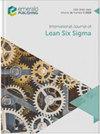土耳其制造商的预测六西格玛:机器学习工具在DMAIC中的应用
IF 3.7
2区 工程技术
Q2 ENGINEERING, INDUSTRIAL
引用次数: 2
摘要
本研究旨在强调利用预测六西格玛来实现基于机器学习(ML)技术的过程改进,该技术嵌入在定义、测量、分析、改进和控制(DMAIC)中。为此,本研究提出了在六西格玛DMAIC的分析和改进阶段,选择和利用ML技术,包括多元线性回归(MLR)、人工神经网络(ANN)、随机森林(RF)、梯度增强机(GBM)和k-近邻(k-NN)。设计/方法/方法使用包含320个观测值的数据集,其中有9个输入变量和1个输出变量。为了达到减少织物缺陷数量的目标,对五种机器学习技术的预测性能进行了比较,并选择了最佳工具。接下来,通过这些工具确定缺陷的最重要原因。最后,以最小缺陷数为目标进行参数优化。在5种机器学习工具中,ANN、GBM和RF被认为是最好的预测因子。在9个潜在原因中,“机器速度”和“织物宽度”是通过使用这些工具确定的最重要的变量。然后,通过回归响应优化器和人工神经网络表面优化,确定织物缺陷最小化的“机器速度”和“织物宽度”的最优值。最终,平均缺陷数从13个/卷减少到3个/卷,这是通过在六西格玛中使用ML技术而获得的相当大的减少。原创性/价值为了弥补六西格玛文献中的一个重要空白,在本研究中,对某些机器学习技术(即MLR、ANN、RF、GBM和k-NN)进行了比较,并将表现最好的技术用于六西格玛DMAIC的分析和改进阶段。本文章由计算机程序翻译,如有差异,请以英文原文为准。
Predictive Six Sigma for Turkish manufacturers: utilization of machine learning tools in DMAIC
Purpose
This study aims to emphasize utilization of Predictive Six Sigma to achieve process improvements based on machine learning (ML) techniques embedded in define, measure, analyze, improve, control (DMAIC). With this aim, this study presents selection and utilization of ML techniques, including multiple linear regression (MLR), artificial neural network (ANN), random forests (RF), gradient boosting machines (GBM) and k-nearest neighbors (k-NN) in the analyze and improve phases of Six Sigma DMAIC.
Design/methodology/approach
A data set containing 320 observations with nine input and one output variables is used. To achieve the objective which was to decrease the number of fabric defects, five ML techniques were compared in terms of prediction performance and best tools were selected. Next, most important causes of defects were determined via these tools. Finally, parameter optimization was conducted for minimum number of defects.
Findings
Among five ML tools, ANN, GBM and RF are found to be the best predictors. Out of nine potential causes, “machine speed” and “fabric width” are determined as the most important variables by using these tools. Then, optimum values for “machine speed” and “fabric width” for fabric defect minimization are determined both via regression response optimizer and ANN surface optimization. Ultimately, average defect number was decreased from 13/roll to 3/roll, which is a considerable decrease attained through utilization of ML techniques in Six Sigma.
Originality/value
Addressing an important gap in Six Sigma literature, in this study, certain ML techniques (i.e. MLR, ANN, RF, GBM and k-NN) are compared and the ones possessing best performances are used in the analyze and improve phases of Six Sigma DMAIC.
求助全文
通过发布文献求助,成功后即可免费获取论文全文。
去求助
来源期刊

International Journal of Lean Six Sigma
Engineering-Industrial and Manufacturing Engineering
CiteScore
8.90
自引率
15.00%
发文量
46
期刊介绍:
Launched in 2010, International Journal of Lean Six Sigma publishes original, empirical and review papers, case studies and theoretical frameworks or models related to Lean and Six Sigma methodologies. High quality submissions are sought from academics, researchers, practitioners and leading management consultants from around the world. Research, case studies and examples can be cited from manufacturing, service and public sectors. This includes manufacturing, health, financial services, local government, education, professional services, IT Services, transport, etc.
 求助内容:
求助内容: 应助结果提醒方式:
应助结果提醒方式:


